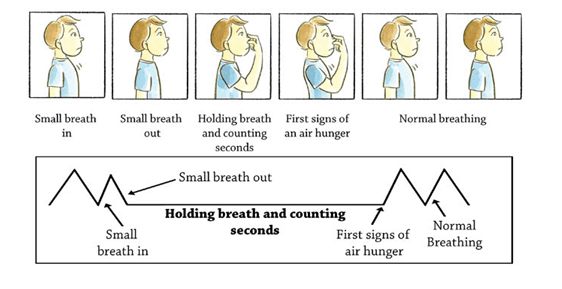Blog
02 Aug 2019
Your Breath
By Laurie Edge-Hughes, BScPT, MAnimSt, CAFCI, CCRT
Ha ha! No, I’m not about to tell you that I know you had onions for lunch or curry for dinner! Instead, I’m going to remind you to breath!

It is a rather well known fact that people in chronic pain also tend to have poor breathing patterns. Shallow breath. Usually only utilizing the top parts of the lungs. Imagine yourself when you have a stomach ache. You sit hunched over or lie curled up. You contract your body to wrap around your sore part, so to speak. However, in doing so, you also compromise your breathing.
Now, a day (or maybe two) of this won’t cause problems. However, should you have long-standing pain or chronic pain, and continue on with that rounded posture and shallow breath pattern, it can have very significant effects.
• The diaphragm develops an abnormal (less effective) position.
• The neck muscles overwork.
• The chest muscles tighten and shorten, affecting the both the torso and the shoulders.
• There is an imbalance between oxygen and carbon dioxide flow.
• As a result of shallow rapid breathing (hyperventilation syndrome), people can experience exhaustion, tingling, cramps, weakness, irregularities of heart rhythm, sensory disturbances and dizziness.
A 2017 study in the Journal of Sport Rehabilitation reviewed literature on breathing programs and their effect on chronic low back pain. From that review, they were able to state that breathing exercise programs are shown to be effective in improving lung function, reducing back pain, and improving quality of life.
A 2014 study demonstrated that breath retraining in patients with neck pain resulted in better neck range of motion.
So, proper breathing can TREAT pain! That’s pretty amazing, because you all own a set of lungs! No gym membership required!
Okay, so how should you breathe? A 2013 study showed that deep slow breathing had a calming effect and helped to reduce pain perception. It was also able to reduce negative feelings (i.e. tension, anger, and depression). The best results were gained when participants combined slow deep breathing with relaxation techniques.
Want some more technique to try? Here are some of my favourites:
1. Stacked Inspiration. I use this when I’m feeling a bit wheezy (like now during haying season). Breath in. Hold for a second. Breath in again. Breath in again. Repeat for a total of 2 or 3 extra breaths in. Then release. You can do 3 full sets of these to really open up your lungs!
2. Buteyko Breathing Method. Exhale all the way out. Then plug your nose and close your mouth. Hold your breath in this manner for as long as you can, until you start to feel a wee bit panicy. Fair warning, it is entirely unpleasant! (My record is 35 seconds). This method really works to clear your sinuses. You’ve got to try it! You may need to do 3 – 5 repetitions.

3. Directed Breathing. With this method, you may want to use your hands, or a Thera-band, or some other touch-point on your body in order to direct your breathing to a certain area. Common areas to direct your breathing are to your lower rib cage or your abdomen. However, you can also direct air to one side of your lungs and then the other. This is sometimes easiest done in side lying or just by bending to one side or the other as you breathe a few times on each side.
The bottom line is. Breathe more. Breathe deeper. And spend a little time to think about, appreciate, and play with your breath.
